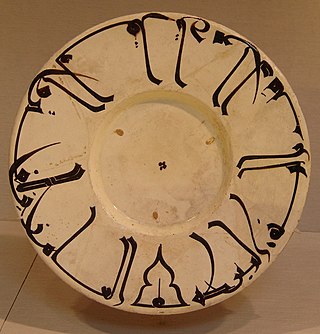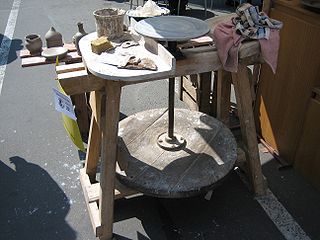A ceramic is any of the various hard, brittle, heat-resistant, and corrosion-resistant materials made by shaping and then firing an inorganic, nonmetallic material, such as clay, at a high temperature. Common examples are earthenware, porcelain, and brick.

Pottery is the process and the products of forming vessels and other objects with clay and other raw materials, which are fired at high temperatures to give them a hard and durable form. The place where such wares are made by a potter is also called a pottery. The definition of pottery, used by the ASTM International, is "all fired ceramic wares that contain clay when formed, except technical, structural, and refractory products". End applications include tableware, decorative ware, sanitary ware, and in technology and industry such as electrical insulators and laboratory ware. In art history and archaeology, especially of ancient and prehistoric periods, pottery often means only vessels, and sculpted figurines of the same material are called terracottas.

Flint, occasionally flintstone, is a sedimentary cryptocrystalline form of the mineral quartz, categorized as the variety of chert that occurs in chalk or marly limestone. Historically, flint was widely used to make stone tools and start fires.

Earthenware is glazed or unglazed nonvitreous pottery that has normally been fired below 1,200 °C (2,190 °F). Basic earthenware, often called terracotta, absorbs liquids such as water. However, earthenware can be made impervious to liquids by coating it with a ceramic glaze, and such a process is used for the great majority of modern domestic earthenware. The main other important types of pottery are porcelain, bone china, and stoneware, all fired at high enough temperatures to vitrify. End applications include tableware and decorative ware such as figurines.

A vase is an open container. It can be made from a number of materials, such as ceramics, glass, non-rusting metals, such as aluminium, brass, bronze, or stainless steel. Even wood has been used to make vases, either by using tree species that naturally resist rot, such as teak, or by applying a protective coating to conventional wood or plastic. Vases are often decorated, and they are often used to hold cut flowers. Vases come in different sizes to support whatever flower is being held or kept in place.

In pottery, a potter's wheel is a machine used in the shaping of clay into round ceramic ware. The wheel may also be used during the process of trimming excess clay from leather-hard dried ware that is stiff but malleable, and for applying incised decoration or rings of colour. Use of the potter's wheel became widespread throughout the Old World but was unknown in the Pre-Columbian New World, where pottery was handmade by methods that included coiling and beating.

Ceramics of Indigenous peoples of the Americas is an art form with at least a 7500-year history in the Americas. Pottery is fired ceramics with clay as a component. Ceramics are used for utilitarian cooking vessels, serving and storage vessels, pipes, funerary urns, censers, musical instruments, ceremonial items, masks, toys, sculptures, and a myriad of other art forms.

Ceramic engineering is the science and technology of creating objects from inorganic, non-metallic materials. This is done either by the action of heat, or at lower temperatures using precipitation reactions from high-purity chemical solutions. The term includes the purification of raw materials, the study and production of the chemical compounds concerned, their formation into components and the study of their structure, composition and properties.
Ceramic foam is a tough foam made from ceramics. Manufacturing techniques include impregnating open-cell polymer foams internally with ceramic slurry and then firing in a kiln, leaving only ceramic material. The foams may consist of several ceramic materials such as aluminium oxide, a common high-temperature ceramic, and gets insulating properties from the many tiny air-filled voids within the material.
This is a list of pottery and ceramic terms.

Fritware, also known as stone-paste, is a type of pottery in which frit is added to clay to reduce its fusion temperature. The mixture may include quartz or other siliceous material. An organic compound such as gum or glue may be added for binding. The resulting mixture can be fired at a lower temperature than clay alone. A glaze is then applied on the surface.
A geopolymer is a vague psuedo-chemical term used to describe inorganic, typically bulk ceramic-like material that forms covalently bonded, non-crystalline (amorphous) networks, often intermingled with other phases. Many geopolymers may also be classified as alkali-activated cements or acid-activated binders. They are mainly produced by a chemical reaction between a chemically reactive aluminosilicate powder e.g. metakaolin or other clay-derived powders, natural pozzolan, or suitable glasses, and an aqueous solution that causes this powder to react and re-form into a solid monolith. The most common pathway to produce geopolymers is by the reaction of metakaolin with sodium silicate, which is an alkaline solution, but other processes are also possible.

The American Ceramic Society (ACerS) is a nonprofit organization of professionals for the ceramics community, with a focus on scientific research, emerging technologies, and applications in which ceramic materials are an element. ACerS is located in Westerville, Ohio.

Solid is one of the four fundamental states of matter along with liquid, gas, and plasma. The molecules in a solid are closely packed together and contain the least amount of kinetic energy. A solid is characterized by structural rigidity and resistance to a force applied to the surface. Unlike a liquid, a solid object does not flow to take on the shape of its container, nor does it expand to fill the entire available volume like a gas. The atoms in a solid are bound to each other, either in a regular geometric lattice, or irregularly. Solids cannot be compressed with little pressure whereas gases can be compressed with little pressure because the molecules in a gas are loosely packed.
Ceramic petrography is a laboratory-based scientific archaeological technique that examines the mineralogical and microstructural composition of ceramics and other inorganic materials under the polarised light microscope in order to interpret aspects of the provenance and technology of artefacts.

Rehydroxylation [RHX] dating is a developing method for dating fired-clay ceramics. This new concept relies on a key property of ceramic materials, in which they expand and gain mass over time. After a ceramic specimen is removed from the kiln at the time of production, it immediately begins to recombine chemically with moisture from the environment. This reaction reincorporates hydroxyl (OH) groups into the ceramic material, and is described as rehydroxylation (RHX). The phenomenon has been well-documented over the past one hundred years, and has now been proposed as a means to date fired-clay ceramics. The RHX process produces an increase in specimen weight and this weight increase provides an accurate measure of the extent of rehydroxylation. The dating clock is provided by the experimental finding that the RHX reaction follows a precise kinetic law: the weight gain increases as the fourth root of the time which has elapsed since firing. This power law and the RHX method which follows from it were discovered by scientists from the University of Manchester and the University of Edinburgh.

Conservation and restoration of ceramic objects is a process dedicated to the preservation and protection of objects of historical and personal value made from ceramic. Typically, this activity of conservation-restoration is undertaken by a conservator-restorer, especially when dealing with an object of cultural heritage. Ceramics are created from a production of coatings of inorganic, nonmetallic materials using heating and cooling to create a glaze. These coatings are often permanent and sustainable for utilitarian and decorative purposes. The cleaning, handling, storage, and in general treatment of ceramics is consistent with that of glass because they are made of similar oxygen-rich components, such as silicates. In conservation ceramics are broken down into three groups: unfired clay, earthenware or terracotta, and stoneware and porcelain.

Ceramic art is art made from ceramic materials, including clay. It may take varied forms, including artistic pottery, including tableware, tiles, figurines and other sculpture. As one of the plastic arts, ceramic art is a visual art. While some ceramics are considered fine art, such as pottery or sculpture, most are considered to be decorative, industrial or applied art objects. Ceramic art can be created by one person or by a group, in a pottery or a ceramic factory with a group designing and manufacturing the artware.
The conservation and restoration of ancient Greek pottery is a sub-section of the broader topic of conservation and restoration of ceramic objects. Ancient Greek pottery is one of the most commonly found types of artifacts from the ancient Greek world. The information learned from vase paintings forms the foundation of modern knowledge of ancient Greek art and culture. Most ancient Greek pottery is terracotta, a type of earthenware ceramic, dating from the 11th century BCE through the 1st century CE. The objects are usually excavated from archaeological sites in broken pieces, or shards, and then reassembled. Some have been discovered intact in tombs. Professional conservator-restorers, often in collaboration with curators and conservation scientists, undertake the conservation-restoration of ancient Greek pottery.

Ancient Egyptian pottery includes all objects of fired clay from ancient Egypt. First and foremost, ceramics served as household wares for the storage, preparation, transport, and consumption of food, drink, and raw materials. Such items include beer and wine mugs and water jugs, but also bread moulds, fire pits, lamps, and stands for holding round vessels, which were all commonly used in the Egyptian household. Other types of pottery served ritual purposes. Ceramics are often found as grave goods.













